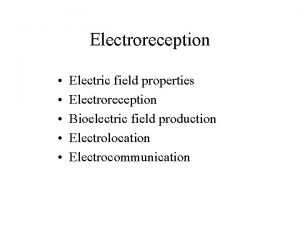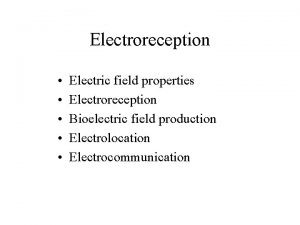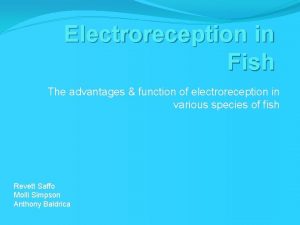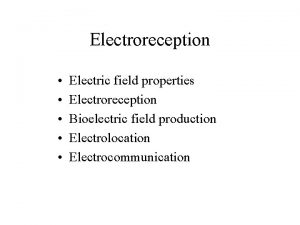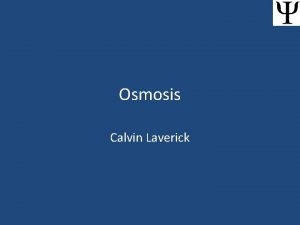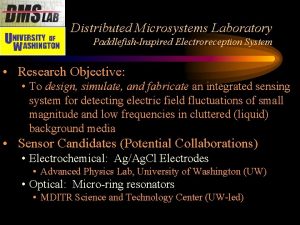ElectroReception Calvin Laverick Why the Power Point Calvin















- Slides: 15

Electro-Reception Calvin Laverick

Why the Power. Point Calvin? • First seen in S 1 E 1 of “Inside the animal mind”. – http: //www. bbc. co. uk/programmes/b 03 thwhf

Definition • Electro reception is the biological ability to perceive natural electrical stimuli.

What animals can use it? • It has been observed almost exclusively in aquatic or amphibious animals. – These include sharks. – It is thought that this is because water is a much better conductor of electricity than air. • A list of known animals can be found here.

• It was thought that electroreception is only found in vertebrates. – However, new research shows that bees can detect the presence and pattern or a static charge on flowers. • The organs needed for electroreception is thought to derive from the Mechanosensory system.

• In most groups of animals electroreception is passive. – This means not under direct mental control. – This is thought to be because it is used in predation. • Predation meaning predatory activities. • An exception to this rule can be found here.

How is it used? • There are 3 main types of use for electroreception: – Electrolocation • Active and passive. – Electrocommunication – Sensory mechanism: • Hence it’s allowance into the Mechanosensory system.

Active Electrolocation • This is when the animal generates electrical fields around itself: – This is by using electroreceptor organs. • It then detects distortions. – A phenomenon known as Jamming Avoidance response can be found here.

Passive Electrolocation • In this process the animal simply detect weak bioelectric fields given off by other animals and uses them to locate the animal. – This bioelectric field is given off by all animals due to the activity of their nerves and muscles. – A second source of this field can be found due to Osmoregulation in ion pumps in the gill membrane.

Electrocommunication • Weakly electric fish can communicate by modulating the electrical waveform they generate. – This is often used for mate attraction and territorial displays.

Sensory Mechanisms • A loose plug of epithelial cells which capacitively couples the sensory receptor cells to the external environment. – This means that they can detect electric communication signals of other fish.

Primary Example • Sharks and rays have organs known as the ampullae of Lorenzini. – These consist of electroreceptor cells connected to the seawater by pores on their snouts and other zones of the head. • It is thought that this is used by sharks to detect the worlds magnetic field and navigate the earth.

Other examples • Electric eel: – Used for attack, navigation and prey detection. • Monotremes: – These include the platypus. • Bees: – They detect a positive static charge while flying through the air.

Effects On Wildlife • An unusual effect is that electromagnetic fields generated by pylons and masts have adverse effects on wildlife.

Sources • http: //en. wikipedia. org/wiki/Electroreception • http: //en. wikipedia. org/wiki/Mechanosensory • http: //en. wikipedia. org/wiki/Jamming_avoida nce_response
 Why why why why
Why why why why Draw power triangle
Draw power triangle Informsu
Informsu Why was john calvin important to the reformation
Why was john calvin important to the reformation Point point power
Point point power Don't ask why why why
Don't ask why why why Hát kết hợp bộ gõ cơ thể
Hát kết hợp bộ gõ cơ thể Ng-html
Ng-html Bổ thể
Bổ thể Tỉ lệ cơ thể trẻ em
Tỉ lệ cơ thể trẻ em Chó sói
Chó sói Glasgow thang điểm
Glasgow thang điểm Alleluia hat len nguoi oi
Alleluia hat len nguoi oi Các môn thể thao bắt đầu bằng tiếng chạy
Các môn thể thao bắt đầu bằng tiếng chạy Thế nào là hệ số cao nhất
Thế nào là hệ số cao nhất Các châu lục và đại dương trên thế giới
Các châu lục và đại dương trên thế giới
















